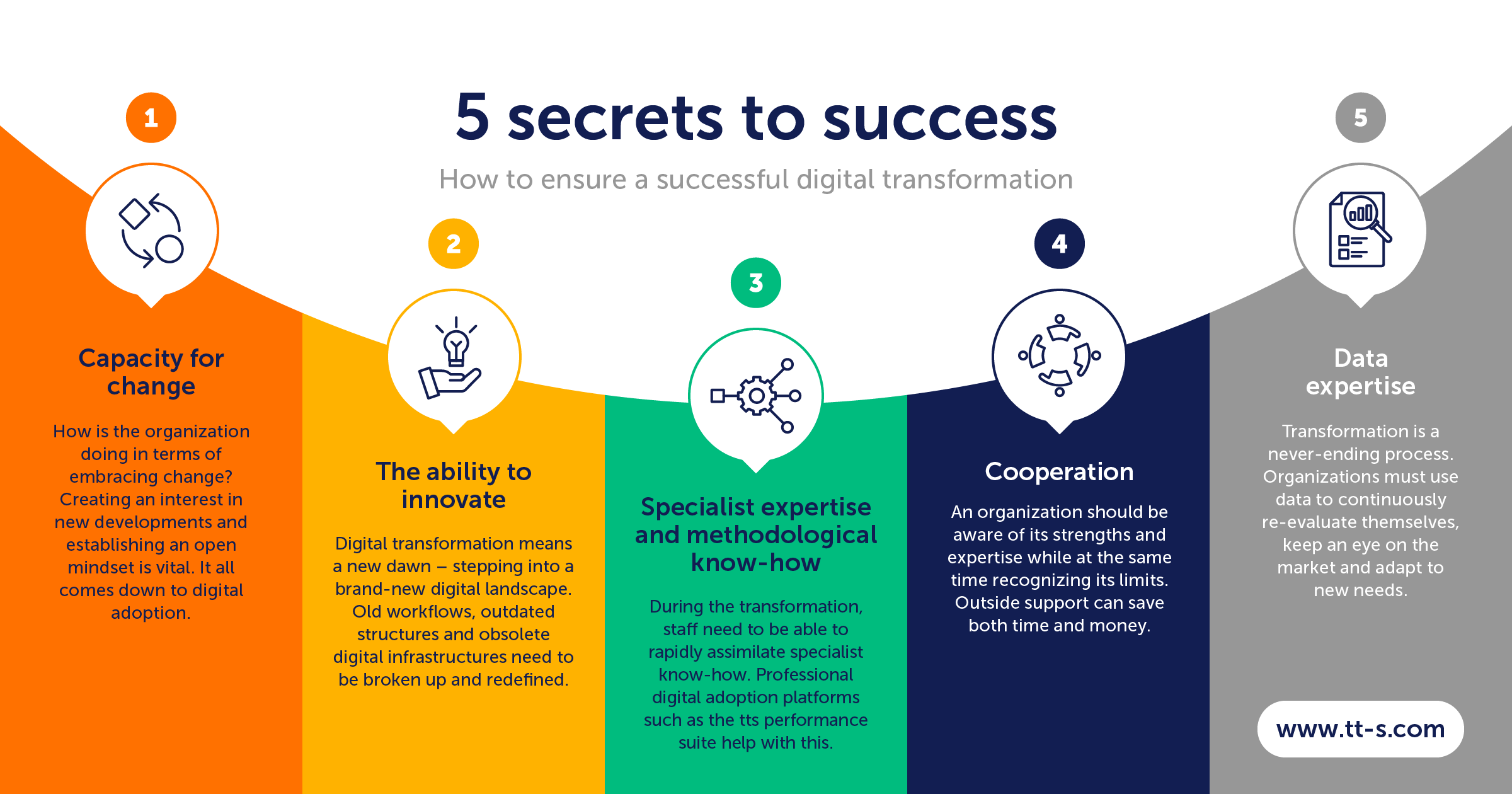Digital transformation – five key success factors
Digital transformation vs. digitization - all just buzzwords? Only those who know the differences can develop the competencies needed for digital transformation and define success factors for their own company: Digitalization primarily means the implementation of digital technologies in existing processes, products and business models. Digital transformation, on the other hand, is the overarching, end-to-end networking of all areas of the economy and adaptation of the players to the new realities of the digital economy. If digital transformation is to succeed, 5 key success factors must be in place: Capacity for change, ability to innovate, specialist expertise and methodological know-how, cooperation, and data expertise.

Although we hear the terms “digital transformation”, “digitization” and “digitalization” on a regular basis, attempts to actually put these concepts into practice tend to fail almost as often. That is because opinions on what these terms actually mean differ widely. Some see them as buzzwords – they sound good in a marketing strategy, but are tricky to define. Others think they all mean the same thing, but that’s a misconception that prevents many companies from successfully transforming their operations on a digital basis.
Digitize, digitalize or digitally transform?
Although these three concepts look similar and are closely related, they have distinct meanings. It can help to think of them as three separate stages:
- Digitization
You could say that it all starts with digitization, perhaps the simplest of the three terms to define. Digitization is the process of converting analog information into a digital format. Photographs, paper documents, video tapes and cassette tapes can all be digitized to preserve or leverage their content. For example, scanning pictures and documents is an effective way to digitize the data they contain so it can be utilized in computer systems. - Digitalization
This is the second stage and is primarily about organizations (whether corporations, medium-sized enterprises or small businesses) using digital technologies in current workflows and existing business models. The aim is to create added value on an effective and efficient basis. New information technology is transforming processes in companies. For instance, training courses and meetings that would previously have taken place in person are now being held digitally using collaboration tools such as Teams. Established procedures such as order entry are also being digitalized thanks to new technologies. Another example would be customers using apps and online shops to place their orders instead of sending them in by mail, fax or email. At every level, digital formats and technologies simplify handling and save both time and money. - Digital transformation
The third stage is to complete the transformation by adopting new business strategies and approaches on an enterprise-wide basis. After all, digitalization can cast doubt not just on individual workflows, but also on entire business models. Companies can use new options such as cloud computing and big data technologies to gain access to new sales channels and digital services. Take, for example, platform companies, which offer goods, real estate and services digitally and have the potential to revolutionize entire sectors. Even startups, when they set themselves up as digital enterprises, can compete with the biggest players in their market. It’s all about revolutionizing business models and the customer experience.
Digitalization is a vehicle
While the definition of digitization is pretty concrete, the distinction between the other two stages is perhaps less clear. Digitalization is a powerful force that can trigger a new way of thinking and that encourages companies to question what has gone before. However, it is worth noting that digital development is not driven solely by internal factors – external circumstances, such as COVID-19, also have a part to play.
What’s more, it is important to remember that although digitalization enables the creation of digital business models, it is not one in its own right. If transformation is the destination, then digitalization and digital technologies are just the vehicle and every company has to find the best route and strategy for getting there.
Digital transformation – a continuous process
This is where “digital transformation” comes in. The phrase covers more than just the digitalization of products, workflows and business models. It is a global concept that factors in all aspects of a business – the customer experience, products, the market and the new economy. The authors of a European case study on digital transformation in industry defined it as follows: “We understand the digital transformation as the seamless, end-to-end connectivity of all areas of the economy, and as the way in which the various players adapt to the new conditions that prevail in the digital economy.” That means digital transformation is a continuous and disruptive process that extends far beyond the definition of digitalization. Digitalization is just one aspect of digital transformation, albeit an integral one.
Companies should adopt a more global outlook and not just rely on technology alone to digitize data and digitalize their operations as they are. If they can’t see the bigger picture, they risk ending up in a situation that was neatly summed up a number of years ago by trained electrical and telecommunications engineer and senior executive Thorsten Dirks:
“If you digitalize a crappy process, then you end up with a crappy digital process!”
Sometimes, this concept of transformation is taken even further – beyond the corporate context. In these cases, it is viewed in very general terms as a continuous process of change that is impacting wider society and the economy. It is also referred to as the digital revolution, in reference to the industrial revolution.

Five secrets for a successful digital transformation (competencies and prerequisites).
How the transformation actually works – five secrets to success
Digital transformation will succeed if products, workflows and business models are understood within the aforementioned context and actually put into practice in day-to-day business. To ensure the transformation works, certain skills are required and certain conditions need to be created – these are the secrets to success, and there are five factors that are crucial:
- Capacity for change
- The ability to innovate
- Specialist expertise and methodological know-how
- Cooperation
- Data expertise
1. Capacity for change – a genuine opportunity
One of the key issues to clarify is how well the company in question embraces change. If you want to take digital transformation seriously, you need to look closely at the organization, initiate a structural and systemic process of change and ensure staff are on board at the same time. Is enough information being shared with employees? Most importantly – are they prepared for the forthcoming change?
For a transformation to be successful, it is vital to create interest in the new arrangement and nurture the right kind of mindset among staff. For everything to work out, the entire company needs to be set to the task. Various roles and aspects can function as positive “drivers” in this – the management team, the corporate culture, the employees themselves, and the organization’s innovative capacity and agility.
For your checklist: How to encourage curiosity and a readiness to change
- How do we respond to changes and what do we need to do better?
- To what extent can organization and corporate culture help us in this respect?
- Which measures and applications can we use to help our staff more when it comes to the capacity for change?
- What part can corporate communications play in this?
2. Innovative capacity – identifying and adopting new approaches
Digital transformation means change – stepping into a brand-new digital landscape. That’s why it is important to be focused when driving forward innovation and to know which direction changes need to take and how to achieve them. This calls for creativity, plenty of ideas and also the courage to adopt a visionary approach and imagine totally new things before they are put into practice. It also takes perseverance, since the task at hand is all about breaking up and redefining old workflows, outdated structures and obsolete digital infrastructures in the organization. As if on an expedition, enterprises sometimes need to enter new territory. Moreover, new approaches may require innovative methods, technologies and strategies that have not been tried out before. This again underscores just how important it is that companies can embrace the spirit of innovation when trying to transform their organization digitally.
For your checklist: How your company can promote a passion for innovation
- What role does innovation play when it comes to setting up internal procedures and how agile are we in our response to changes in the market?
- How innovative are our strategies and corporate culture and what can we improve?
- Which agile and new methods and technologies might help drive innovative capacity in the company?
- How keen are our staff on innovation? Do they have the information and skills required?
3. Specialist expertise and methodological know-how – rapid know-how transfer is essential
Digitalization transforms products, workflows and business models. From the perspective of staff, who get new tasks and roles as a result, this development poses a real challenge. They are the players in day-to-day procedures and the users of the new, digital technologies. This means they need to be integrated into an ongoing learning process, since companies need to constantly adapt to changing market conditions.
This makes specialist expertise and methodological know-how all the more important. Staff should be in a position where they can rapidly assimilate specialist knowledge. To do that, they need access to the right methods and tools and they must know how to use them. This is where the management team comes in – it must make the right material and technologies available to its workforce.
For your checklist: How to take learning to a whole new level
- What new specialist expertise and methodological know-how do we need in the company?
- What specialist expertise and methodological know-how do our staff have already?
- How can we give staff precisely the training they need so we can build up the specialist expertise and methodological know-how we need in the company?
- Which digital applications, methods, technologies, content or platforms will help us achieve that best?
4. Cooperation – networking with partners
When embarking on a difficult journey, it’s best not to travel alone. The same applies to digital transformation. That’s why it is important to understand your organization’s strengths and expertise while at the same time recognizing your limits and knowing when it’s a good idea to seek outside support. There are always experts that a company can turn to at any time – and doing so saves time and money. In the ideal scenario, a partnership can be the thing that tips the balance in your favor and helps you edge ahead of the competition.
For your checklist: How to benefit from a partnership
- Which skills and capabilities do we have and which do we need to acquire?
- In which specific areas do we need outside support and is it worth establishing a longer-term partnership?
- Which type of partnership is suitable and what should the partner provide?
5. Data expertise – finding and reading the right sources
Digital transformation never stops. Companies must continuously re-evaluate themselves, keep an eye on the market and constantly realign themselves to meet demands and needs that have arisen. To do that, they need data – and the right sort. This needs to be collected, analyzed and then correctly interpreted. Different companies in different sectors have different priorities when it comes to data. They might use information from production to make operations run more smoothly on a digital basis, or use customer data to develop or improve products digitally.
For your checklist: How to make the most of your data
- What type of information is strategically important for implementing our projects?
- What type of data can we already harvest and what insights can we gain from it?
- How can gaps in information or content be closed?
- Which evaluation processes have we already established and how can we make good use of data for digital development?
To summarize, digitization is a method that uses technology to convert analog information into a digital format, while digitalization is a vehicle that uses technology to make digital transformation possible. When correctly understood and implemented, digital technologies can help companies make crucial progress and get in shape for the future – particularly as part of a strategic transformation. This also requires a change in mindset. It is only when a company has achieved this that it will be well prepared on a long-term basis for a successful future.




